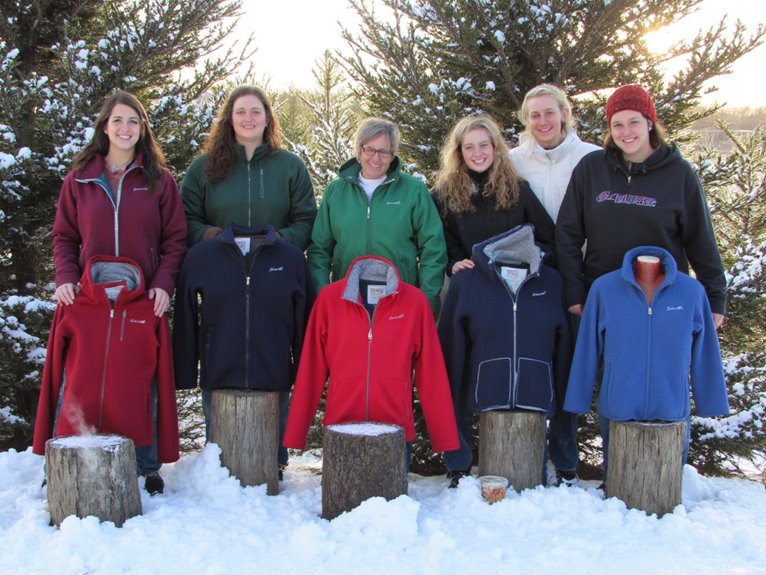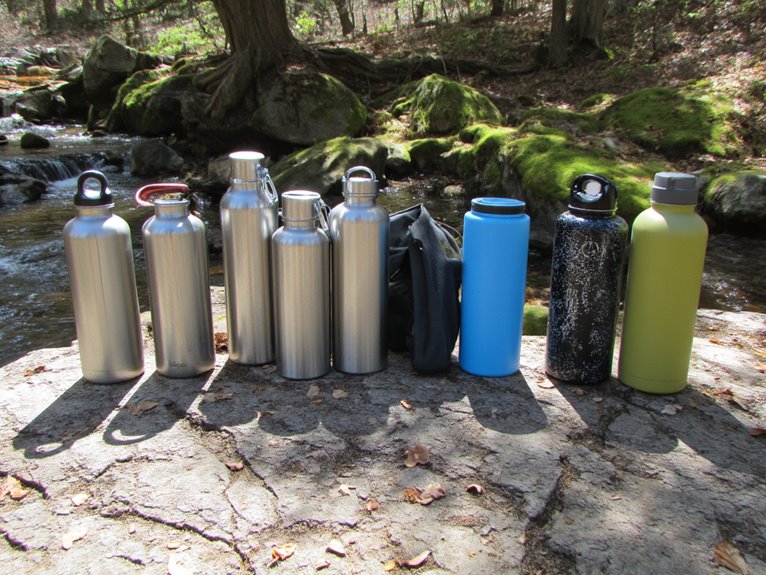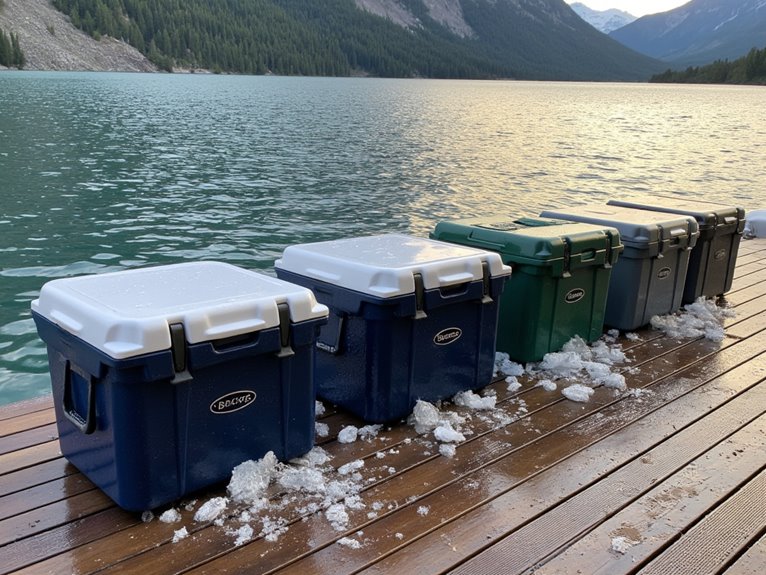Can I Wear Black on a Hike?
Wearing black on a hike is not recommended as it can lead to discomfort, fatigue, and even heat-related illnesses. Dark-colored clothing absorbs up to 90% of solar radiation, converting it into heat and increasing heat gain. This can cause dehydration, making your hike more challenging. While black clothing may provide warmth in cold weather, it's not ideal for most hiking conditions. By understanding the science behind color choice, you can make informed decisions about your attire. Investigate alternative colors and fabrics that balance aesthetics with performance, and discover how to make the most of your hiking experience.
We are supported by our audience. When you purchase through links on our site, we may earn an affiliate commission, at no extra cost for you. Learn more. Last update on 1st January 2026 / Images from Amazon Product Advertising API.
Heat Absorption in Dark Colors
Dark-colored clothing, including black, has a propensity to absorb heat due to its low albedo, a characteristic that can have significant implications for hikers.
This means that dark colors can make hikers feel hotter, leading to discomfort, fatigue, and even heat-related illnesses.
In hot weather, it's essential to prioritize clothing that allows for adequate ventilation and cooling.
Dark colors can also increase the risk of dehydration, as the body struggles to regulate its temperature.
By opting for lighter-colored clothing, hikers can reduce their risk of heat-related issues and enjoy a more comfortable hiking experience.
It's vital for hikers to ponder the implications of dark-colored clothing on their body temperature and overall well-being.
The Science Behind Color Choice
In selecting attire for outdoor activities, understanding the science behind color choice is vital.
The way fabrics interact with their surroundings has a significant impact on the wearer's comfort and safety.
Heat Absorption Explained
Most outdoor enthusiasts are unaware that the primary reason black clothing absorbs excessive heat is due to its low albedo value, a measure of how much sunlight is reflected by a surface.
Dark colors, particularly black, have a low albedo, which means they absorb a significant amount of solar radiation, converting it into heat. This results in increased temperatures on the skin, making the wearer feel hotter.
In contrast, light-colored clothing has a higher albedo, reflecting most of the sun's radiation and keeping the wearer cooler.
Understanding albedo is vital in making informed decisions about clothing choices for outdoor activities, especially in warm weather conditions. By grasping this fundamental principle, hikers can make more informed decisions about their attire to stay comfortable and safe on the trails.
Fabric Color Effectiveness
Choosing the right fabric color can substantially impact thermal comfort during outdoor activities, as different hues exhibit varying levels of solar radiation absorption and reflection.
Dark colors, such as black, absorb more radiation, leading to increased heat gain, while lighter colors reflect it, keeping the wearer cooler.
Dark colors (black, navy, dark brown) absorb up to 90% of solar radiation, increasing heat gain.
Light colors (white, beige, light gray) reflect up to 80% of solar radiation, reducing heat gain.
Earth tones (olive, tan, rust) absorb around 60% of solar radiation, offering moderate heat gain.
Bright colors (orange, yellow, red) reflect around 70% of solar radiation, providing a balance between heat gain and visibility.
Nature's Color Harmony
In the natural world, the strategic use of coloration is a vital component of survival, as it enables organisms to blend in, communicate, or even camouflage themselves, and this inherent harmony between color and environment can inform our own color choices for outdoor activities.
By observing nature's color palette, we can learn to make informed decisions about the colors we wear on a hike.
Earthy tones such as olive green, brown, and tan allow us to blend in with the surroundings, reducing visibility and minimizing our impact on the environment.
Conversely, bright colors like yellow and orange can serve as a warning signal to wildlife, making them more likely to avoid us.
Black Clothing in Cold Weather
When venturing out into cold weather, does wearing black clothing hinder or help the body's ability to regulate its temperature?
In cold climates, black clothing can be beneficial as it absorbs heat from the body, helping to retain warmth. However, it's essential to consider the fabric and layering.
Retains heat: Black clothing absorbs heat from the body, keeping you warm in cold conditions.
Moisture management: Look for breathable, moisture-wicking fabrics to prevent cold sweat buildup.
Layering: Wear black as a base layer, and add lighter-colored outer layers to balance heat retention and visibility.
Wind resistance: Consider wind-resistant fabrics to prevent cold air penetration.
Hiking in Direct Sunlight
Hiking in direct sunlight poses a different challenge, as dark-colored clothing can become a heat trap, accelerating heat gain and potentially leading to heat exhaustion.
In hot and sunny conditions, black clothing can absorb and retain heat, making the wearer feel even hotter.
This is particularly concerning for hikers, as heat exhaustion can set in quickly.
To mitigate this risk, consider wearing light-colored, breathable clothing that allows for airflow and moisture wicking.
Additionally, take regular breaks in shaded areas and stay hydrated to avoid heat-related illnesses.
Moisture and Dark Fabrics
In the realm of wearing black on a hike, the combination of dark fabrics and moisture can be a recipe for discomfort.
Dark fabrics tend to trap moisture, which can lead to clammy skin, chafing, and even blisters.
This moisture-trapping phenomenon can be particularly problematic on long hikes, where the buildup of sweat can exacerbate these issues.
Dark Fabric Drawbacks
Dark fabrics, including black, have a propensity to absorb moisture, which can lead to clamminess and discomfort during physical activity.
This can be particularly problematic on a hike, where sweating is inevitable and evaporation is essential for maintaining body temperature. Dark fabrics can exacerbate this issue, making it difficult for the body to cool down.
Some key drawbacks of dark fabrics include:
- Slower drying times, leading to prolonged discomfort
- Increased sweat buildup, which can lead to chafing and irritation
- Higher risk of heat exhaustion due to trapped heat
- Reduced visibility in low-light conditions, posing a safety risk
Moisture Trapping Risks
Trapped moisture in dark fabrics can lead to a buildup of sweat and bacteria, creating an ideal environment for skin irritation and infection.
This is particularly concerning for hikers, as skin issues can quickly escalate into more serious problems when miles from medical attention.
Dark fabrics like black cotton or polyester tend to retain moisture, preventing it from evaporating quickly. This creates a warm, humid microclimate next to the skin, perfect for bacterial growth.
As a result, hikers wearing dark clothing may experience increased sweating, chafing, and discomfort.
To minimize these risks, consider wearing breathable, moisture-wicking fabrics that allow for efficient evaporation and drying.
Comfort Vs. Functionality Debate
Hikers often find themselves at a crossroads, torn between prioritizing comfort and sacrificing functionality or vice versa, a dilemma that can substantially impact the overall hiking experience.
The comfort-driven approach may lead to choosing clothing that provides ease of movement and relaxation, but may compromise on essential features such as breathability, water resistance, or sun protection.
On the other hand, prioritizing functionality may result in a more practical outfit, but may lead to discomfort and restricted movement.
Black clothing can trap heat, causing discomfort and fatigue.
Functionality-focused clothing may lack flexibility and mobility.
Prioritizing comfort may lead to neglecting essential safety features.
Finding a balance between comfort and functionality is vital for a successful hike.
Alternative Colors for Hiking
Beyond black, a palette of alternative colors exists for hikers seeking to balance aesthetics with performance.
Earthy tones such as olive green, terracotta, and sandy beige are excellent options, as they blend seamlessly with natural environments. These colors also provide a level of camouflage, reducing the visibility of dirt and stains.
For a more vibrant approach, consider blues and greens, which can add a pop of color to your hiking attire without sacrificing functionality. Look for moisture-wicking fabrics in these hues to guarantee top-notch performance.
Considerations for Long Hikes
When setting out on extended hikes, it's essential to prioritize comfort and practicality in your attire, as even the slightest discomfort can become amplified over time, compromising your overall performance.
On long hikes, it's crucial to consider factors that may impact your experience.
Choose breathable, quick-drying materials to keep you dry and comfortable with moisture-wicking fabrics.
Pack layers that can be easily added or removed to adapt to changing temperatures with layered clothing.
Opt for clothing with seamless construction to reduce chafing and irritation.
Incorporate reflective or bright colors into your attire to increase visibility in low-light conditions with reflective or bright colors.
Making Informed Choices
By carefully considering the factors that impact hiking performance, individuals can make informed decisions about their attire, ensuring a more comfortable and successful experience.
When choosing what to wear, hikers should weigh the pros and cons of different colors, fabrics, and styles.
For instance, dark colors like black may absorb heat, while light colors can reflect it.
Moisture-wicking fabrics can help regulate body temperature, while cotton can retain sweat.
By evaluating these factors, hikers can select clothing that suits their specific needs and preferences.





